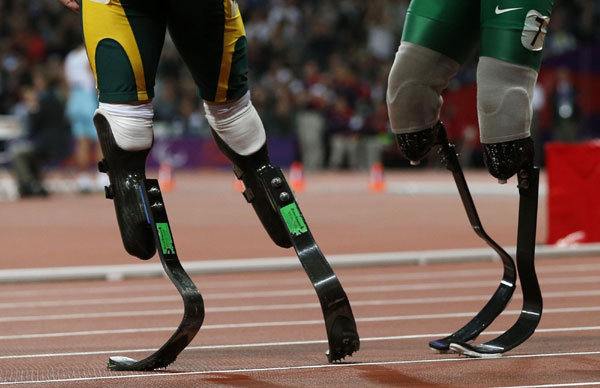Pistorius shows disabled sport can stand controversy
Updated: 2012-09-04 10:32
(Agencies)
|
||||||||
LONDON - South African "blade runner" Oscar Pistorius has unleashed a debate about disabled sport with an emotional claim that a rival in the T44 200 metres final at the London Paralympics beat him thanks to longer prosthetic legs.
Pistorius had not been beaten over 200m for nine years, but the result of Sunday's final was less of a shock than the post-race outburst of a man who is the face of disabled sport partly thanks to his dignified campaign to be allowed to challenge able-bodied runners at the Olympics.
"The size of some of the other guys' legs are unbelievably long," Pistorius told Britain's Channel 4 television.
"We're not racing a fair race. The International Paralympic Committee (IPC) have the regulations, but the regulations allow the athletes to make themselves unbelievably high."
Besides detracting from the victory of Brazil's Alan Oliveira, it was a surprising rant from a man who had convinced sports administrators that his own carbon-fibre blades gave him no advantage over able-bodied runners.
So can Paralympic medals be decided by the length of an artificial leg? And where does that leave a branch of sport striving to be taken as seriously as able-bodied sport?
Slippery Slope
If Pistorius has a case, it is certainly not that Oliveira's longer blades give him a longer stride.
South African-based sports scientist and coach Ross Tucker pointed out on his blog "The Science of Sport" that Oliveira took 98 strides to Pistorius's 92.
John Brewer, Director of Sport at the University of Bedfordshire in Britain, said the advantages of longer blades were not clear.
"With any lever, the length could leverage more force, but I also suspect that longer blades would increase instability," he said.
Pistorius accepts Oliveira's blades were legal. This means Pistorius could also have used them, if he had been prepared to change from the blades that he was authorised to wear against able-bodied runners at the London Olympics four weeks ago.
"This situation may be a reason to force Paralympians to use the same kind of technology, while of course adjusting to their individual body types," said Andy Miah, Director of the Creative Futures Institute at the University of the West of Scotland.
"The big question emerging from the T44 200m final is whether the Paralympic rules need to be tighter ... If Oliveira's prosthetic legs are bigger and better and legal, then Pistorius really ought to get some."
But how to tighten the rules?
Pistorius was born without proper lower legs. It might be possible to work out the leg length of an average person with Pistorius's upper body, but Pistorius is not average.
"In elite athletes ... the ranges that you'd find in the normal population don't apply," Tucker wrote, adding that Oliveira may just have been catching up with Pistorius in finding his personal optimal blade length.
"If you're wondering about whether Pistorius has a valid argument, then welcome to the slippery slope that is the introduction of technology with no clear answers to the sport."

 'Taken 2' grabs movie box office crown
'Taken 2' grabs movie box office crown
 Rihanna's 'Diamonds' tops UK pop chart
Rihanna's 'Diamonds' tops UK pop chart
 Fans get look at vintage Rolling Stones
Fans get look at vintage Rolling Stones
 Celebrities attend Power of Women event
Celebrities attend Power of Women event
 Ang Lee breaks 'every rule' to make unlikely new Life of Pi film
Ang Lee breaks 'every rule' to make unlikely new Life of Pi film
 Rihanna almost thrown out of nightclub
Rihanna almost thrown out of nightclub
 'Dark Knight' wins weekend box office
'Dark Knight' wins weekend box office
 'Total Recall' stars gather in Beverly Hills
'Total Recall' stars gather in Beverly Hills
Most Viewed
Editor's Picks

|

|

|

|

|

|
Today's Top News
Health new priority for quake zone
Xi meets US top military officer
Japan's boats driven out of Diaoyu
China mulls online shopping legislation
Bird flu death toll rises to 22
Putin appoints new ambassador to China
Japanese ships blocked from Diaoyu Islands
Inspired by Guan, more Chinese pick up golf
US Weekly

|

|







